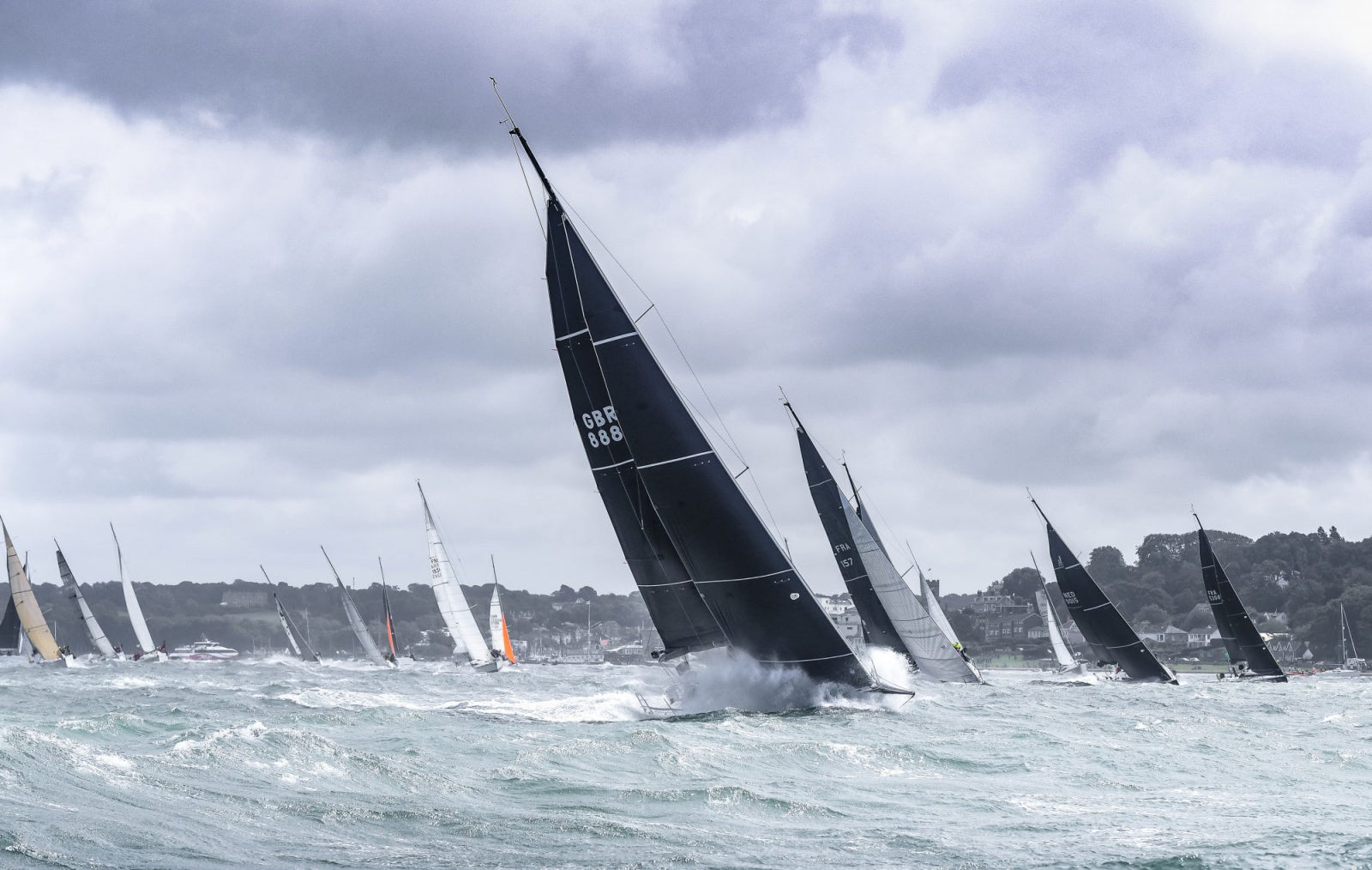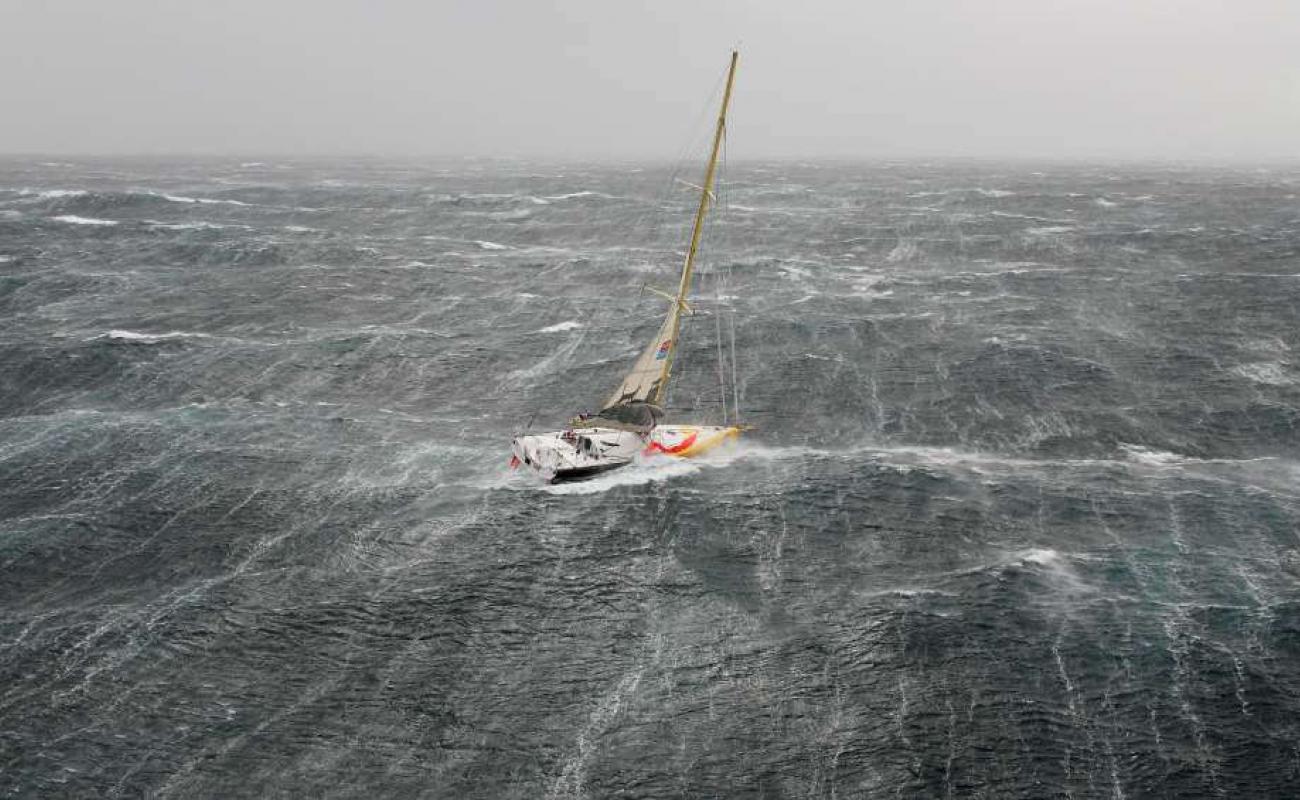HOW TO SAIL SAFELY THROUGH A STORM
HOW TO SAIL SAFELY THROUGH A STORM
Tips And Tricks To Help You Get Home Safe

Compared to the quick response and sudden nature of a squall, sailing through a storm in open water is an endurance contest. In addition to big wind, you’ll have to deal with big waves and crew fatigue.
Sailing in Waves
Sailing in big waves is a test of seamanship and steering, which is why you should put your best driver on the helm. Experienced dinghy sailors often are very good at heavy air steering, because they see “survival” weather more often than most cruisers.
Avoid sailing on a reach across tall breaking waves; they can roll a boat over. When sailing close-hauled in waves, aim toward flat spots while keeping speed up so you can steer. To reduce the chance of a wave washing across the deck, tack in relatively smooth water. A cubic foot of water weighs 64 pounds, so a wave can bring many hundreds of pounds of water across the deck.
Sailing on a run or broad reach in big waves is exhilarating, but be careful not to broach and bring the boat beam-to a breaker. Rig a preventer to hold the boom out.

Storm Sails
If reefing isn’t enough to reduce power, it’s time to dig out your storm sails — the storm trysail and storm jib. They may seem tiny, but since wind force rises exponentially, they’re the right size for a really big blow. Storm trysails are usually trimmed to the rail, but some modern ones are set on the boom. The storm jib should be set just forward of the mast to keep the sail plan’s center of effort near the boat’s center of lateral resistance. This helps keep the boat in balance.
Storm Strategy
The first decision before an approaching storm is the toughest: Run for cover, or head out to open water for sea room? With modern forecasting, a true storm will rarely arrive unannounced, but as you venture further offshore the chances of being caught out increase. While running for cover would seem the preferred choice, the danger lies in being caught in the storm, close to shore, with no room to maneuver or run off.
Two classic storm strategies are to try to keep away from land so you’re not blown up on shore, and to sail away from the storm’s path — especially its “dangerous semicircle,” which is its right side as it advances.
Storm Tactics
Storm tactics help you handle a storm once you’re in it. There are several proven choices, all of which aim to reduce the strain and motion by pointing one of the boat’s ends (either bow or stern) toward the waves. No one tactic will work best for all boats in all conditions.
Sail under storm jib and deeply reefed mainsail or storm trysail. This approach provides the most control. Sails give you the power to steer and control your boat in the waves.
Run before the storm with the stern toward the waves, perhaps towing a drogue to slow the boat. This tactic requires a lot of sea room, and the boat must be steered actively. Another concern is that you will remain in front of an approaching storm, rather than sailing out of its path.
Heave-to on a close reach with the jib trimmed to windward. Heaving-to can be an excellent heavy weather tactic, though some boats fare better than others.
Deploy a sea anchor while hove-to or under bare poles. A sea anchor is a small parachute set at the end of a line off the bow. A sea anchor helps keep the bow up into the waves so the boat won’t end up beam to the seas. One concern is the load on the rudder as waves push the boat aft.
Another alternative is lying ahull, simply sitting with sails down. This passive alternative is less reliable than the other tactics, as you lose the ability to control your angle to the waves and may end up beam to the seas. Furthermore, the motion of the boat rolling in the waves without the benefit of sails can be debilitating.
Want to order a storm trysail or storm jib for your boat? Contact a North Sails Expert here.
How to Heave-To
Wouldn’t it be great if, during a heavy air sail, you could just take a break, and relax for a bit? Imagine a short respite from the relentless pitching and pounding: a chance to rest, take a meal, or check over the boat in relative tranquility. Well, you can. The lost art of heaving-to allows you to “park” in open water.
To heave-to, trim the jib aback (i.e., to the wrong side), trim the main in hard, and lash the helm so the boat will head up once it gains steerageway. As the jib tries to push the bow down, the bow turns off the wind and the main fills, moving the boat forward. Once the boat begins to make headway, the lashed helm turns the boat toward the wind again. As the main goes soft the jib once again takes over, pushing the bow down. The main refills, and the rudder pushes the bow into the wind again.
The boat won’t actually stop. It will lie about 60 degrees off the wind, sailing at 1 or 2 knots, and making significant leeway (sliding to leeward). The motion will be much less than under sail, and dramatically more stable and pleasant than dropping all sails and lying ahull. You will also be using up less sea room than if you run before the storm at great speed.
Achieving this balance will require some fine tuning, depending on the wind strength, your boat design, and the sails you are flying. Also, fin-keeled boats do not heave to as well as more traditional designs.
In storm seas, some boats will require a sea anchor off the bow to help hold the boat up into the waves while hove-to.

Alternate Storm Strategy: Don’t Go
If conditions are wrong, or are forecast to worsen, don’t go. If you can avoid the storm, then do so.
If you’re at home, stay there. If you’re mid-cruise, button up the boat, make sure your anchor or mooring or dock lines are secure, and then read a book or play cards. Relax. Enjoy the time with your shipmates. Study the pile of Owners’ Manuals you’ve accumulated with each piece of new gear. Tinker with boat projects.
Put some soup on the stove, and check on deck every so often to make sure the boat is secure. Shake your head as you return below, and remark, “My oh my, is it nasty out there.”
If your boat is threatened by a tropical storm or hurricane, strip all excess gear from the deck, double up all docking or mooring lines, protect those lines from chafe, and get off. Don’t risk your life to save your boat.
Misery and Danger
Although everyone will remember it differently years later, a long, wet, cold sail through a storm can be miserable. As the skipper, you need to make the best of it: watch over your crew, offer relief or help to those who need it, and speak a few words of encouragement to all. “This is miserable, but it will end.”
Take the time to marvel at the forces of nature, and at your ability to carry on in the midst of the storm. Few people get to experience the full fury of a storm. It may not be pleasant, but it is memorable.
While misery and discomfort can eventually lead to fatigue, diminished performance, and even danger, do not mistake one for the other. Distinguish in your own mind the difference between misery and danger. Don’t attempt a dangerous harbor entrance to escape misery; that would compromise the safety of the boat and crew, just to avoid a little discomfort.
Interested in a new sail quote or have questions about your sails? Fill out our Request a Quote form below and you will receive a reply from a North sail expert in your area.



























